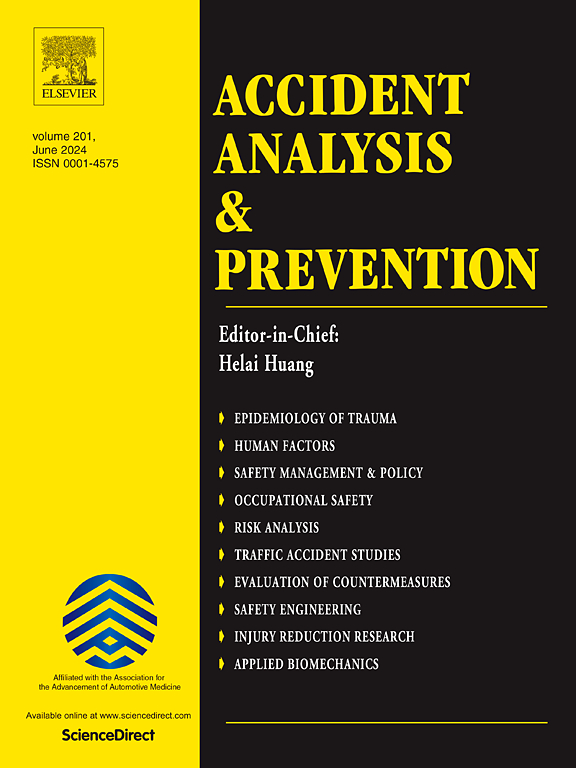基于多任务学习预测变道操作及相关碰撞风险
IF 5.7
1区 工程技术
Q1 ERGONOMICS
引用次数: 0
摘要
车辆的变道操作(LC)对高速公路交通安全有重大影响。因此,主动预测 LC 机动性和相关碰撞风险至关重要。然而,以往的变道风险预测研究大多忽视了变道机动的预测,限制了其实际效用。此外,随着预测范围的扩大,低速行驶机动识别的效果也趋于一般。为了填补这些空白,本文提出了一种多任务学习模型,该模型可同时预测 LC 机动的概率、LC 风险等级和变线时间(TTLC),同时进一步分析 LC 机动与 LC 风险之间的内在相关性。该模型由一个卷积神经网络(CNN)和两个长短期记忆网络(LSTM)组成。CNN 用于从动态驾驶环境中提取和融合共享特征,而一个 LSTM 专门用于估计 LC 机动和 TTLC 的概率,另一个 LSTM 则侧重于估计 LC 风险水平。在 HighD 数据集上对所提出的方法进行的评估证明了其卓越的性能。它几乎可以预测车辆越过车道边界前 2 秒内的所有低速行驶动作,对高风险低速行驶级别的召回率高达 80%。即使在跨越车道边界前 3.6 秒,该模型仍能预测约 95% 的低速行驶操纵。多任务学习策略的使用增强了模型对交通场景的理解和预测的稳健性。基于 HighD 数据集的 LC 风险分析表明,左侧和右侧变道的风险分布和影响因素有所不同。在右侧变道中,碰撞风险主要来自当前车道上的前车和后车;而在左侧变道中,碰撞风险主要来自当前车道上的前车和目标车道上的后车。所提出的方法可应用于高级驾驶员辅助系统(ADAS),在高速公路驾驶过程中可靠地早期识别 LC,同时纠正潜在的危险 LC 机动,确保驾驶安全。本文章由计算机程序翻译,如有差异,请以英文原文为准。
Predicting lane change maneuver and associated collision risks based on multi-task learning
The lane-changing (LC) maneuver of vehicles significantly impacts highway traffic safety. Therefore, proactively predicting LC maneuver and associated collision risk is of paramount importance. However, most of the previous LC risk prediction research overlooks the prediction of LC maneuver, limiting its practical utility. Furthermore, the effectiveness of LC maneuver recognition tends to be moderate as the prediction horizon extends. To fill the gaps, this paper proposes a multi-task learning model that simultaneously predicts the probability of LC maneuver, LC risk level, and time-to-lane-change (TTLC), while further analyzing the intrinsic correlation between LC maneuver and LC risk. The model consists of a Convolutional Neural Network (CNN) and two Long Short-Term Memory networks (LSTM). The CNN is employed to extract and fuse shared features from the dynamic driving environment, while one LSTM is dedicated to estimating the probability of LC maneuver and TTLC, and the other LSTM focuses on estimating the LC risk level. Evaluation of the proposed method on the HighD dataset demonstrates its excellent performance. It can almost predict all LC maneuvers within 2 s before the vehicle crosses lane boundaries, with an 80% recall rate for high-risk LC levels. Even 3.6 s before crossing lane boundaries, the model can still predict approximately 95% of LC maneuvers. The use of the multi-task learning strategy enhances the model’s understanding of traffic scenarios and its prediction robustness. LC risk analysis based on the HighD dataset shows that the risk distribution and influencing factors for left and right lane changes differ. In right lane changes, collision risks primarily arise from the leading and following vehicles in the current lane, while in left lane changes, collision risks mainly stem from the leading vehicle in the current lane and the following vehicle in the target lane. The proposed approach can be applied to advanced driver assistance systems (ADAS) to reliably and early identify LC during highway driving, while correcting potentially dangerous LC maneuvers, ensuring driving safety.
求助全文
通过发布文献求助,成功后即可免费获取论文全文。
去求助
来源期刊

Accident; analysis and prevention
Multiple-
CiteScore
11.90
自引率
16.90%
发文量
264
审稿时长
48 days
期刊介绍:
Accident Analysis & Prevention provides wide coverage of the general areas relating to accidental injury and damage, including the pre-injury and immediate post-injury phases. Published papers deal with medical, legal, economic, educational, behavioral, theoretical or empirical aspects of transportation accidents, as well as with accidents at other sites. Selected topics within the scope of the Journal may include: studies of human, environmental and vehicular factors influencing the occurrence, type and severity of accidents and injury; the design, implementation and evaluation of countermeasures; biomechanics of impact and human tolerance limits to injury; modelling and statistical analysis of accident data; policy, planning and decision-making in safety.
 求助内容:
求助内容: 应助结果提醒方式:
应助结果提醒方式:


